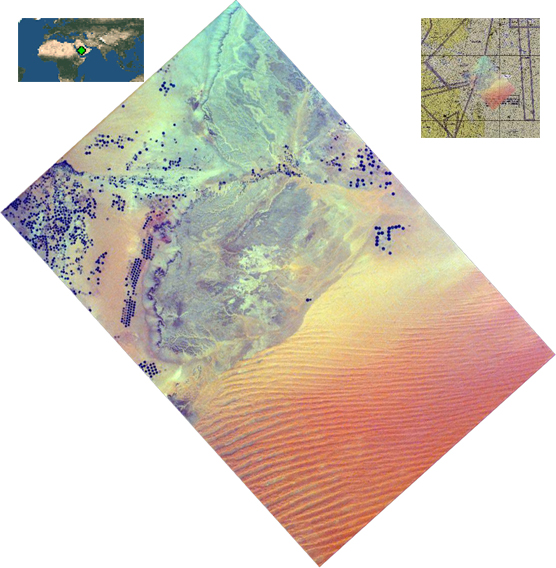Favorite Image: STS081.ESC.01002957
Sand dunes and center-pivot irrigation in Saudi Arabia
This image shows pivot irrigation near the city of As Sulayyil (Sulayel), Saudi Arabia. The edge of the Rub' al-Khali, or Empty Quarter, is visible in the southeast.
Modern drilling, pumping, and distribution systems have permitted many arid and semiarid regions of the world to become productive farmlands. The circular features that dot the desert landscape are created by pivoting sprinklers, a method of irrigation whereby water from a central well is spread by a sprinkler pivoting around the well. Center-pivot irrigation is most often used in arid and semiarid regions of the world. The diameter of these circular fields can vary from several hundred feet to more than a mile. Dark circles represent fields where crops are presently grown; faint circles outline field patterns where no crops are being grown. Some fields have been taken out of production to lie fallow, some have been harvested or planted with new crops, and others have been taken out of production indefinitely. The water used in the fields is extracted from subsurface reserves that infiltrated deep aquifers during geological periods when the climate was much wetter than at present. Center-pivot irrigation is not unique to Saudi Arabia, and there is danger in that there is a finite supply of "fossil" water for irrigation use.
The Rub' al-Khali is a vast desert found in the southern Arabian Peninsula. It covers about 250,000 square miles in a structural basin that lies mainly in southeastern Saudi Arabia, with lesser portions in Yemen, Oman, and the United Arab Emirates. It is the largest area of continuous sand in the world and encompasses more than one-quarter of Saudi Arabia. The topography is varied. In the west the elevation reaches as high as 2,000 feet and the sand is fine and soft. In the east the elevation drops to 600 feet with sand dunes, salt flats, and sand sheets. One of the driest regions in the world, it is virtually uninhabited and remains largely unexplored.
Modern drilling, pumping, and distribution systems have permitted many arid and semiarid regions of the world to become productive farmlands. The circular features that dot the desert landscape are created by pivoting sprinklers, a method of irrigation whereby water from a central well is spread by a sprinkler pivoting around the well. Center-pivot irrigation is most often used in arid and semiarid regions of the world. The diameter of these circular fields can vary from several hundred feet to more than a mile. Dark circles represent fields where crops are presently grown; faint circles outline field patterns where no crops are being grown. Some fields have been taken out of production to lie fallow, some have been harvested or planted with new crops, and others have been taken out of production indefinitely. The water used in the fields is extracted from subsurface reserves that infiltrated deep aquifers during geological periods when the climate was much wetter than at present. Center-pivot irrigation is not unique to Saudi Arabia, and there is danger in that there is a finite supply of "fossil" water for irrigation use.
The Rub' al-Khali is a vast desert found in the southern Arabian Peninsula. It covers about 250,000 square miles in a structural basin that lies mainly in southeastern Saudi Arabia, with lesser portions in Yemen, Oman, and the United Arab Emirates. It is the largest area of continuous sand in the world and encompasses more than one-quarter of Saudi Arabia. The topography is varied. In the west the elevation reaches as high as 2,000 feet and the sand is fine and soft. In the east the elevation drops to 600 feet with sand dunes, salt flats, and sand sheets. One of the driest regions in the world, it is virtually uninhabited and remains largely unexplored.








